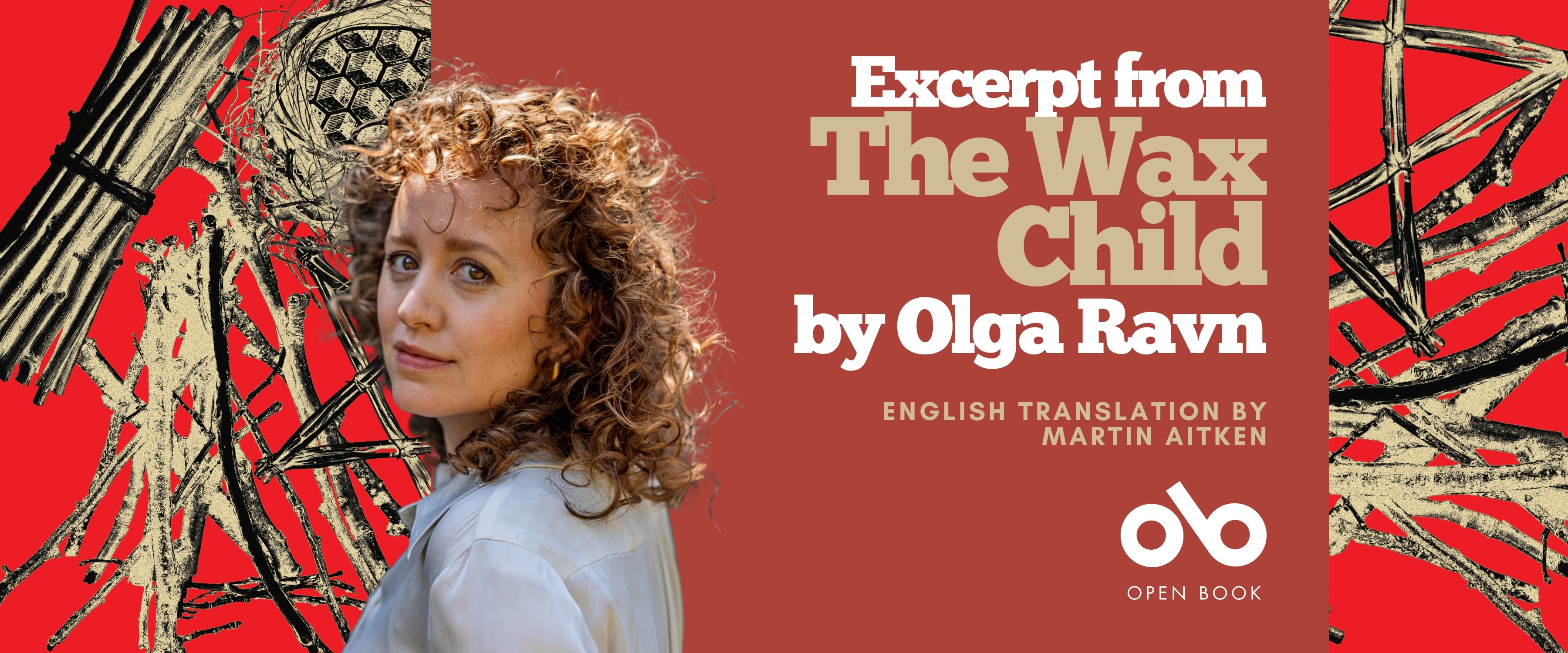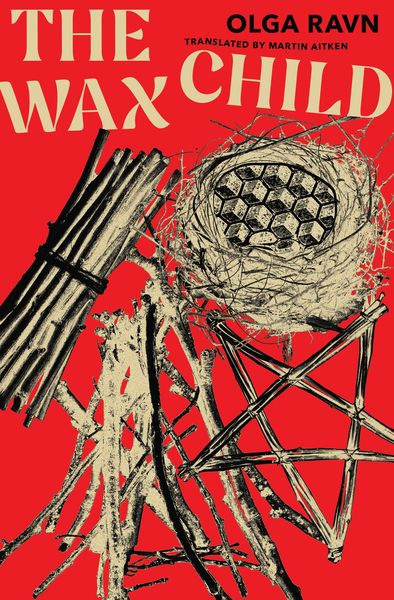Read an Excerpt from THE WAX CHILD by Olga Ravn (Translated by Martin Aitken)
With The Wax Child (Book*hug Press), internationally celebrated author Olga Ravn returns with a story that is as haunting as it is breathtakingly original. Translated from the Danish by Martin Aitken, this spellbinding novel transports readers into seventeenth-century Denmark, a world alive with superstition, fear, and whispered accusations. Following the global success of The Employees and My Work, Ravn once again blurs the boundary between the historical and the uncanny, crafting a gothic masterpiece about power, faith, and survival.
At the heart of the story is Christenze Kruckow, an unmarried noblewoman whose quiet life unravels when she and several other women are accused of witchcraft. As rumours spread of possession and pacts with the Devil, their fates become bound to a mysterious creation—a wax doll fashioned by Christenze one shadowed night in 1620. Through this doll’s eerie narration, Ravn channels the voices of the accused and the silenced, conjuring a world where truth and illusion merge, and where terror seeps through every prayer and dream.
Based on true witchcraft trials in Northern Jutland, The Wax Child blends archival fragments, letters, and grimoires into lush, lyrical prose that feels both timeless and vividly new. Aitken’s masterful translation captures Ravn’s hypnotic rhythm and emotional precision, bringing her chilling vision to English readers with uncanny grace. The result is a novel that will haunt readers long after the final page—a dark meditation on history, cruelty, and the fragile power of storytelling itself.
If you want to get a taste of this spectacular translated work, you can do so right here with an excerpt that we're thrilled to share with readers!
An Excerpt from THE WAX CHILD by Olga Ravn (Translated by Martin Aitken)
I was a child shaped in beeswax. I was made like a doll the size of a human forearm. They had given me hair and fingernail parings from the persons who were to suffer. And again I was carried, this time by Maren, for many weeks under her clothing, and I was like a proper child, and my wax was softened by her warmth, but I was missing my first mistress. When the evening came and the carrying period was passed, something began to tremble in me, like a bluebell in the wind upon a cliff. It was the night of St. Lucia, the twelfth of December, and the year was 1620. In Maren’s sleeping room, all were gathered.
There was Christenze and Maren. There was Dorte and Apelone. There was Mette, and someone called Elle, and Maren Pedersdatter and Margrethe Hjulmands, and the wife of Gunder Vognkarl, and there was Christen Knudsen’s woman and an old wife from Vorde whose name was Ane or Maren, and a Mette from Klarup, Else from Mov, Bodil and Sidsel from Gudum.
Maren entered with a candle in her hand and lay down upon the floor as if to give birth, and the others drew me out from under her skirts like I was a human child. And everyone laughed and sang and fell about each other, and Maren looked up at Christenze with that light in her eyes and Christenze had to kiss her.
It is true that someone was meant to be stricken, that someone was meant to suffer. These fingernail parts, these strands of hair Maren had meticulously pressed into my wax foot. But first and foremost they wished to commit to each other, first and foremost they wished to seal their association, to summon the golden servant, and now it was here, I took its place, and the women’s hearts were up in their mouths, all of them opened their mouths and looked agitatedly around at each other, and in every mouth was seen a lustrous fleshy heart, and every one did fill the room with its drumming; even I, who have no heart, felt as if my own was in my mouth, and I cannot describe the sense of joy it gave me, and the moment stretched into infinity, time dissolved inside their circle, they took each other by the hand and began slowly to dance around me with their open heart-mouths. One after another they approached and spat into my face, and each then did swallow her heart, which slithered back into its proper place and was changed by the experience. And when Christenze’s spit fell on my brow I nearly burst with arousal. The candles flickered and made it look like they were dancing upon a bonfire of shadows. They had initiated me with their spit, and they called me Elisabeth, for the fingernails and hair they had given into my foot besides their own were hers, I felt it immediately. But before they were able to complete the initiation, a banging was heard upon the windowpane and outside in the darkness a terrible face appeared.
It’s Peder! Apelone cried.
Your CanLit News
Subscribe to Open Book’s newsletter to get local book events, literary content, writing tips, and more in your inbox
Yes, in all damnation it is! he screeched back. Maren, you hag, so it’s true, that you gad about for the sake of mischief!
His gaze went from one to another, and again he screeched into the wind, Do you think I’m stupid? When you are so many women together, it can only be in devilish pursuits! Even an idiot knows. I’ll run now and tell the bailiff and the mayor.
His figure vanished. A distant light reflected in the black water of the fjord. They all stood transfixed and stared at each other. Then hell broke loose, and with much screaming and shouting they gathered their things and ran out of the house as fast as their feet could carry them. Maren snatched me up and set fire to my foot, the one in which the fingernails of the pastor David Klyne’s wife were pressed, and I felt nothing other than a tension subside. Only the girl, Karen, remained after all others but her mother had fled, and she had seen it all.
Come here to me, sweetheart, Maren said, and the girl climbed onto Maren’s lap, and there the woman sat and rocked her child and tried to stem the tears that were rolling down her face. She tipped back her head and opened her mouth in a silent scream. I saw the heart in her mouth once more. And the aorta spoke to me, signs as chains of gold in the night. With an arc of her foot Maren swept me underneath the bed.
Mother, ask me what a laceband is, said the girl.
What is a laceband?
It is a kind of ribbon by which to tie one’s shirt.
That’s right. Now it’s time to sleep.
____________________________________________
Olga Ravn is one of Denmark’s most celebrated contemporary authors. She is also a poet, a literary critic, and an editor. Her novel The Employees was shortlisted for the International Booker Prize and the Ursula K. Le Guin Prize and longlisted for the National Book Awards and the Dublin Literary Award. It has been published in twenty-five territories, and film rights have been sold. Her novel My Work won the Politikens Literature Prize and led to changes in Denmark’s maternity laws. It was published in English in 2023 to great critical acclaim. Ravn’s work has also been published in the New Yorker, Granta, and The Paris Review. Her latest novel, The Wax Child, based on a series of real witch trials from the 17th century, was published in Denmark in September 2023.
Martin Aitken has translated the work of contemporary Scandinavian writers such as Karl Ove Knausgaard, Peter Høeg, Ida Jessen, and Kim Leine. He was a finalist at the US National Book Awards 2018 and received the PEN America Translation Prize 2019 for his translation of Hanne Ørstavik’s Love. His translation of Olga Ravn’s The Employees was shortlisted for the 2021 International Booker Prize. Aitken lives in Denmark.








